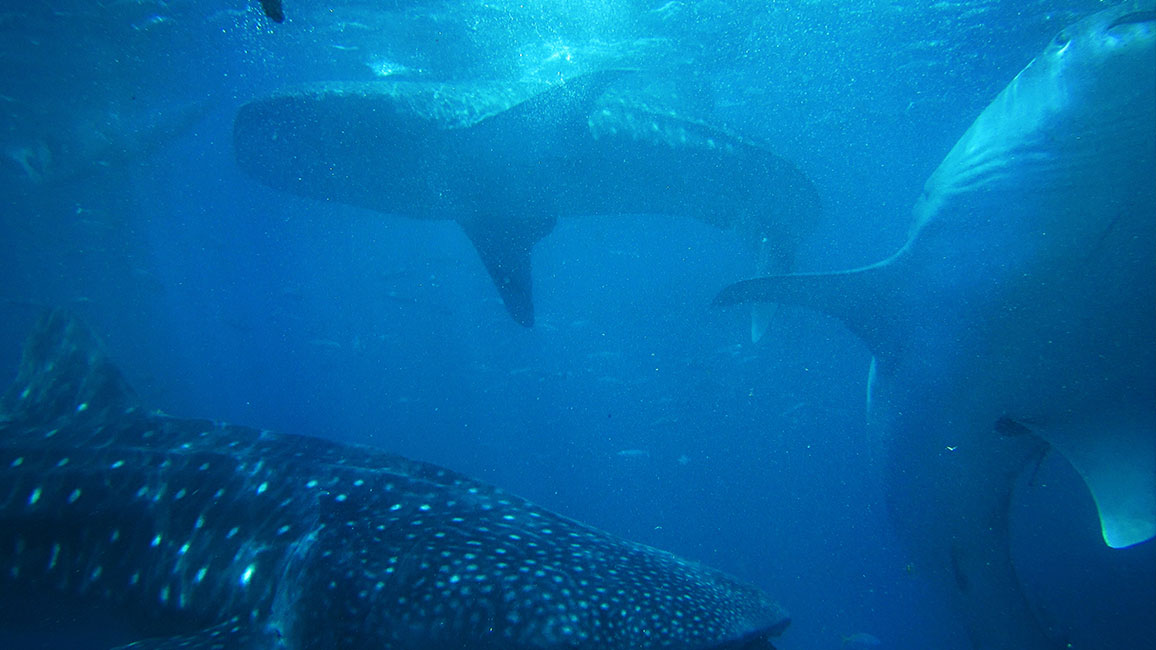
Is That a Shark?
By Kathy KrankingWhat do you picture when you think of a shark? A torpedo-shaped body? Big, sharp teeth? As you’ll soon see, a shark can still be a shark without having the typical shark look.
The biggest thing that all sharks have in common is something you can’t see: They have cartilage instead of bones. (This cartilage is like the tough rubbery stuff that cushions the bones in your knees.) Read on to see how not-like-a-shark some sharks can be.

WHAT A BIGMOUTH!
The school bus-sized basking shark (above) has a gigantic mouth. But its teeth are smaller than grains of rice, and pretty useless. That’s no problem for the shark, though. To eat, it swims along slowly with its mouth wide open. As water flows in, tiny creatures get caught on bristly gill rakers. The shark swallows this food, and the water flows back out past its gills, which the shark uses to breathe.
WOBBE-GONE?
Being flat and flappy is a good way to stay hidden. And hiding is what the wobbegong (WOH-buh-gong) shark does best. Can you see it lying on the coral (top photo)? Its color and pattern help it blend in. And the flaps and frings make it look like anything but a hungry shark. But if a fish or other prey gets too close, the wobbegong lunges into action sucking the prey right into its mouth like a vacuum cleaner.
NO ANGEL
The eastern angel shark (above left) has a flat body that makes it look more like its ray cousins than a shark. Its long, wide side fins look like wings, which is how it got its name. But though it may have the wings of an angel, it sure doesn’t act like one to the small animals it eats. An angel shark lies on the ocean bottom, often buried in sand. When a fish or other prey creature swims near, the angel shark lunges at it. Chomp! It grabs the prey with its trap-like jaws and gobbles it up.
SHARP SURPRISE
A California horn shark (above) spends most of the day hiding in caves or under rock ledges. It comes out at night to hunt for crabs, fish, and other prey. Sometimes a bigger shark or other predator will try to make a meal of a horn shark. But it’s a tough meal to swallow! Two horn-like spines on the shark’s top fins may make a predator quickly spit it out.
SHIMMERY SHARK
Here’s a bright idea for disappearing: The velvet-belly lantern shark camouflages itself with light! See those glowing spots on the shark’s skin (left top photo)? They’re called photophores (FOH-tuh-fors), and they’re all over the shark’s body, even on its belly. In the dark waters where the shark lives, the only light comes from above. So to predators swimming below it, the glowing shark blends into the light. It’s like the shark is invisible!
THE NOSE KNOWS
The mysterious goblin shark (left) lives in the dark depths of the ocean. Check out its big paddle-shaped snoot. It has special sensors that can pick up electrical currents. All living things give off these currents. So the sensors help the shark find squid, fish, crabs, and other prey. When it finds a meal, the goblin shark has a deadly trick: Its jaws shoot forward out of its mouth to grab the prey.
Whether they have big noses or tiny teeth, glow-in-the-dark skin or flat-as-a-pancake bodies, these creatures are all sharks!
“Is That A Shark?” originally appeared in the July 2011 issue of Ranger Rick magazine.
(Click on each image above for a closer view of the story.)


















